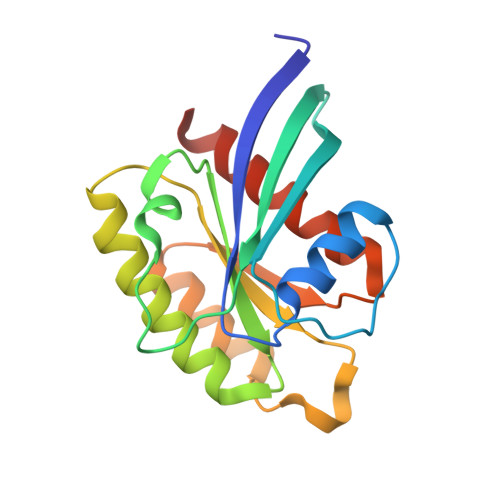Structural Basis for the Unique Biological Function of Small GTPase RHEB
Yu, Y., Li, S., Xu, X., Li, Y., Guan, K., Arnold, E., Ding, J.(2005) J Biol Chem 280: 17093-17100
- PubMed: 15728574
- DOI: https://doi.org/10.1074/jbc.M501253200
- Primary Citation of Related Structures:
1XTQ, 1XTR, 1XTS - PubMed Abstract:
The small GTPase Rheb displays unique biological and biochemical properties different from other small GTPases and functions as an important mediator between the tumor suppressor proteins TSC1 and TSC2 and the mammalian target of rapamycin to stimulate cell growth. We report here the three-dimensional structures of human Rheb in complexes with GDP, GTP, and GppNHp (5'-(beta,gamma-imide)triphosphate), which reveal novel structural features of Rheb and provide a molecular basis for its distinct properties. During GTP/GDP cycling, switch I of Rheb undergoes conformational change while switch II maintains a stable, unusually extended conformation, which is substantially different from the alpha-helical conformation seen in other small GTPases. The unique switch II conformation results in a displacement of Gln64 (equivalent to the catalytic Gln61 of Ras), making it incapable of participating in GTP hydrolysis and thus accounting for the low intrinsic GTPase activity of Rheb. This rearrangement also creates space to accommodate the side chain of Arg15, avoiding its steric hindrance with the catalytic residue and explaining its noninvolvement in GTP hydrolysis. Unlike Ras, the phosphate moiety of GTP in Rheb is shielded by the conserved Tyr35 of switch I, leading to the closure of the GTP-binding site, which appears to prohibit the insertion of a potential arginine finger from its GTPase-activating protein. Taking the genetic, biochemical, biological, and structural data together, we propose that Rheb forms a new group of the Ras/Rap subfamily and uses a novel GTP hydrolysis mechanism that utilizes Asn1643 of the tuberous sclerosis complex 2 GTPase-activating protein domain instead of Gln64 of Rheb as the catalytic residue.
Organizational Affiliation:
Key Laboratory of Proteomics, Institute of Biochemistry and Cell Biology, Shanghai Institutes for Biological Sciences, Chinese Academy of Sciences and Graduate School of the Chinese Academy of Sciences, 320 Yue-Yang Road, Shanghai 200031, China.

















